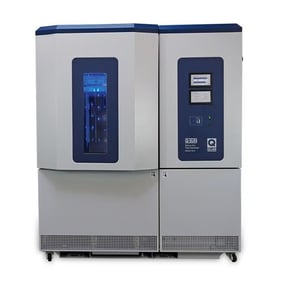Accelerated weathering testing is essential for predicting how materials degrade under the forces of sunlight, heat, and moisture. Two of the most widely used standards for this purpose are ASTM G154 and ASTM G155, each offering distinct methods for simulating outdoor conditions in the lab.
In this post, we’ll break down the key differences between these standards, outline which equipment is best suited for each, and help you decide which is right for your material or product.
What is ASTM G154?
ASTM G154 is the standard practice for using fluorescent UV lamps to simulate the damaging effects of sunlight. It’s ideal for testing plastics, coatings, textiles, rubber, and other nonmetallic materials. G154 utilises controlled cycles of UV light, heat, and moisture (primarily through hot condensation) to replicate years of outdoor exposure in a matter of weeks.
✅ Key Highlights:
-
Light Source: UVA-340 or UVB-313 fluorescent lamps
-
Moisture: Primarily hot condensation, with optional water spray
-
Temperature: Typically 60 °C during light, 50 °C during condensation
-
Typical Tester: QUV Accelerated Weathering Tester
The QUV tester is specifically designed to meet ASTM G154 requirements and is the world’s most widely used device for fluorescent UV weathering testing.
What is ASTM G155?
ASTM G155 outlines how to use xenon arc lamps to expose materials to a broader, full-spectrum light that closely replicates natural sunlight. It’s used across industries, especially where colour, aesthetics, or full-spectrum photodegradation are critical, such as in the automotive, textile, and architectural coatings sectors.
✅ Key Highlights:
-
Light Source: Xenon arc with Daylight, Window Glass, or Extended UV filters
-
Moisture: Front/back water spray and humidity control
-
Temperature: Up to 89 °C with black panel; RH-controlled environments
-
Typical Tester: Q-SUN Xenon Test Chamber
The Q-SUN tester meets all ASTM G155 conditions and provides flexible programming, full-spectrum exposure, and high realism for indoor and outdoor weathering simulations.
Side-by-Side Comparison
| Feature | ASTM G154 | ASTM G155 |
|---|---|---|
| Light Source | Fluorescent UV (UVA-340, UVB-313) | Xenon Arc (full-spectrum) |
| Spectral Accuracy | UV only | Closest match to sunlight |
| Moisture Simulation | Hot condensation, some spray | Water spray & humidity control |
| Test Speed | Faster (harsher UVB option) | Slower but more realistic |
| Primary Use | Formulation screening, UV-driven aging | Appearance testing, full-spectrum degradation |
| Testers | QUV Tester | Q-SUN Xenon Tester |
| Cost & Complexity | Lower cost, simpler operation | Higher cost, greater realism |
Pros and Cons
✔️ ASTM G154 – Fluorescent UV Testing
Pros
-
Simple, cost-effective, and widely accepted
-
Excellent for comparing UV resistance
-
Hot condensation provides realistic moisture simulation
-
Ideal for flat or 3D samples
-
Perfect match with QUV tester capabilities
Cons
-
Doesn’t simulate visible or IR light
-
May miss certain colour or temperature-related effects
✔️ ASTM G155 – Xenon Arc Testing
Pros
-
Most realistic sunlight simulation
-
Wide range of test cycles for many industries
-
Includes humidity control for wet/dry cycles
-
Compatible with global performance standards
-
Q-SUN testers offer flexibility and automation
Cons
-
Some legacy cycles (e.g. Cycle 1) may be outdated or slow
-
Higher cost and maintenance requirements
-
Test cycles don't define material pass/fail criteria
Which Standard Should You Use?
-
Choose ASTM G154 (QUV tester) if you need:
-
Fast, cost-effective UV testing
-
Comparative screening of plastics or coatings
-
Reliable hot condensation moisture exposure
-
-
Choose ASTM G155 (Q-SUN tester) if:
-
Your material is sensitive to colour change or full-spectrum exposure
-
You need a realistic simulation of sunlight
-
You’re testing automotive, textiles, or high-end architectural finishes
-
Conclusion
ASTM G154 and G155 are both powerful tools in your weathering test strategy. G154 delivers speed and simplicity for UV-driven degradation, while G155 offers unmatched realism for total sunlight exposure. Your choice depends on your material, budget, and testing goals.
Need help selecting the right tester or test cycle? Contact us today. We’ll help you find the best solution for your weathering test needs.






